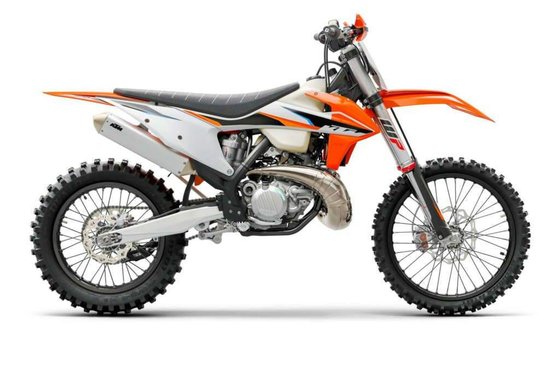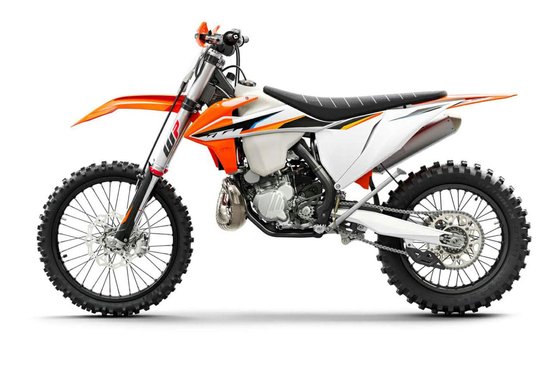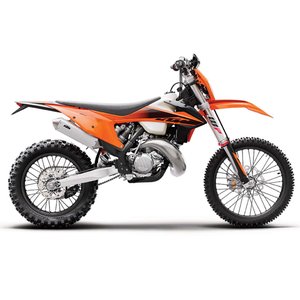KTM 300 EXC TPI (2017-2020): The Ultimate Enduro Weapon Tested

Introduction
The KTM 300 EXC TPI (2017-2020) isn’t just a dirt bike—it’s a statement. As the first production two-stroke enduro motorcycle with fuel injection, this generation rewrote the rules of off-road performance. Designed for riders who demand relentless power, razor-sharp handling, and bulletproof reliability in extreme terrain, the 300 EXC TPI became an instant legend. After spending days thrashing it through rocky trails, muddy hill climbs, and tight single-track, here’s why this bike remains a benchmark for hardcore enduro enthusiasts.
Engine & Power Delivery: Two-Stroke Revolution
At the heart of the KTM 300 EXC TPI lies its 293.2cc two-stroke engine, now equipped with the groundbreaking Transfer Port Injection (TPI) system. Unlike traditional carbureted two-strokes, the TPI eliminates premixing fuel while delivering crisp throttle response across the entire RPM range.
Key Takeaways:
- Controlled Fury: The TPI system ensures smooth low-end torque that’s almost four-stroke-like, making it impossible to stall on technical climbs. Yet, when you crack the throttle wide open, it unleashes a visceral mid-to-top-end rush that’s pure two-stroke adrenaline.
- No Jetting, No Problems: Ride from sea level to high-altitude mountain passes without touching a carburetor screw. The Continental/Synerject EMS auto-adjusts fueling, a game-changer for adventure riders.
- Electric Start Dominance: While earlier models retained a kickstarter (2017-2019), the 2020 model went electric-only—a controversial but practical move given the system’s reliability.
By the Numbers:
- Peak Power: ~50 HP (estimated)
- Fuel Efficiency: 2.79 L/100 km (84.3 MPG) – exceptional for a 300cc two-stroke.
- Weight: 103 kg (227 lbs) dry – lighter than most 450cc four-strokes.

Chassis & Handling: Precision Meets Brutality
KTM’s chromoly steel frame and WP XACT suspension form a chassis that’s both forgiving and razor-sharp.
Frame Dynamics:
- Flex-Tuned Rigidity: The frame absorbs trail chatter but remains precise during aggressive cornering. Laterally mounted engine head stays reduce vibrations, a blessing during marathon rides.
- Ground Clearance: 370 mm (14.6") lets you glide over logs and rocks without a second thought.
Suspension Setup:
- Front: The 48mm WP XACT-USD fork offers 300 mm (11.8") of travel. Adjustable compression/rebound lets you dial in plushness for rocks or stiffness for MX-style jumps.
- Rear: The WP XACT monoshock (310 mm/12.2" travel) pairs with a linkage-less PDS system. Purists argue it’s simpler and lighter; others miss the tunability of a linkage. Either way, it eats up harsh landings.
Handling Verdict:
Flickable in tight woods yet stable at speed, the 300 EXC TPI dances between agility and composure. The 63.9° head angle and 1,482 mm wheelbase strike a perfect balance for enduro versatility.
Ergonomics & Comfort: Built for War
KTM’s "Ready to Race" ethos shines in the cockpit:
- Seat Height: 960 mm (37.8") is towering for shorter riders but provides leverage for standing attacks. Aftermarket low seats are a popular MOTOPARTS.store upgrade.
- Handlebar Setup: The Neken aluminum bar (standard bend) offers a neutral riding position. We’d swap in a vibration-damping grip for multi-hour rides.
- Fuel Capacity: 9.0 liters (2.38 gal) gives ~100 km (62 mi) range – sufficient for enduro loops but consider a larger tank for adventure use.
Standout Feature: The tool-less air filter access is genius. After a mud bath, swapping filters takes 30 seconds—no screwdrivers needed.
Competition: How It Stacks Up
1. Husqvarna TE 300i
- Similarities: Same TPI engine, identical suspension travel.
- Differences: Husky’s composite subframe and Pro Taper bars offer minor ergonomic tweaks. The KTM feels marginally more aggressive in power delivery.
- Verdict: Choose based on dealer proximity or color preference (Husky’s white vs. KTM’s orange).
2. Beta 300 RR
- Strengths: Softer power curve, lower seat height (935 mm/36.8"), better for technical trail riders.
- Weaknesses: Carbureted (until 2021), heavier at 108 kg (238 lbs).
- Verdict: Beta suits finesse riders; KTM dominates in outright speed.
3. Yamaha YZ250X
- Strengths: Legendary reliability, $2k cheaper.
- Weaknesses: Carbureted, no electric start, harder-hitting powerband.
- Verdict: A budget pick for MX-trained riders; outdated vs. TPI tech.
Maintenance: Keeping the Beast Alive
The 300 EXC TPI is low-maintenance but demands attention to key areas:
1. TPI System Care
- Injectors: Clean annually with ultrasonic tools (available at MOTOPARTS.store).
- Oil Pump: Use only JASO FD-certified injector oil (e.g., Motorex CrossPower 2T).
2. Suspension Service
- Forks: Rebuild every 80-100 hours. Upgrade to SKF seals for muddy conditions.
- Shock: Nitrogen recharge every 50 hours maintains consistent damping.
3. Exhaust Upgrades
The stock HD pipe is durable but heavy. Swap in an FMF Gnarly for weight savings + torque gains.
4. Top-End Rebuilds
- Interval: 150-200 hours for recreational riders. Pistons and gaskets are a MOTOPARTS.store bestseller.
5. Critical MOTOPARTS.store Recommendations:
- Air Filters: Twin Air Dual-Stage filters for extreme dust.
- Brake Pads: Sintered Brembo pads for aggressive downhill control.
- Chain Kits: DID 520ERT3 Gold for longevity.
Conclusion: Why It Still Dominates
The KTM 300 EXC TPI (2017-2020) is a rare machine that combines cutting-edge tech with raw two-stroke soul. Whether you’re clawing up a root-infested hill or blitzing a desert wash, it rewards skill and punishes complacency—exactly what enduro riders crave. While newer models have emerged, this generation remains a used-market darling and a testament to KTM’s engineering audacity.
Ready to personalize yours? MOTOPARTS.store has everything from performance pipes to grippy footpegs—because even legends can level up.
Specifications sheet
| Engine | |
|---|---|
| Stroke: | Two-stroke |
| Fuel system: | TPI (Transfer Port Injection), Dell’Orto 39 mm Throttle Body |
| Lubrication: | Electronically Regulated Oil Pump |
| Displacement: | 293 ccm |
| Configuration: | Single |
| Cooling system: | Liquid cooled |
| Compression ratio: | N/A (2-stroke engine) |
| Number of cylinders: | 1 |
| Dimensions | |
|---|---|
| Wheelbase: | 1482 mm (58.3 in) |
| Dry weight: | 103 |
| Seat height: | 960 mm (37.8 in) |
| Ground clearance: | 370 mm (14.6 in) |
| Fuel tank capacity: | 9.5 L (2.51 US gal) |
| Drivetrain | |
|---|---|
| Chain type: | X-Ring 5/8 x 1/4 (520 pitch) |
| Final drive: | chain |
| Transmission: | 6-speed |
| Rear sprocket: | 50 |
| Front sprocket: | 14 |
| Maintainance | |
|---|---|
| Rear tire: | 110/100-18 |
| Front tire: | 90/90-21 |
| Brake fluid: | DOT 4 |
| Spark plugs: | Specific 2-stroke TPI plugs (exact model not specified) |
| Coolant type: | Water-based coolant |
| Final drive adjustment: | 520 chain with 14/50 sprockets |
| Additional Features | |
|---|---|
| Handlebar: | NEKEN aluminum tapered handlebar |
| Air filter: | Twin Air filter with tool-free access |
| Exhaust system: | 3D-stamped HD exhaust pipe with reinforced ribs |
| Instrumentation: | LCD display |
| Starting system: | Electric starter |
| Chassis and Suspension | |
|---|---|
| Frame: | Central double-cradle-type 25CrMo4 steel |
| Rear brakes: | Single 220 mm disc, Brembo 1-piston caliper |
| Front brakes: | Single 260 mm disc, Brembo 2-piston caliper |
| Rear suspension: | WP XACT Monoshock with linkage |
| Front suspension: | 48 mm WP XACT-USD fork |
| Rake (fork angle): | 63.9° |
| Rear wheel travel: | 310 mm (12.2 in) |
| Front wheel travel: | 300 mm (11.8 in) |



















